概述(Linux Media Subsystem Documentation — The Linux Kernel documentation)
video4linux2(V4L2)是 Linux 内核中关于视频设备的内核驱动,它为 Linux中视频设备访问提供了通用接口,在 Linux 系统中,V4L2驱动的Video设备节点路径通常/dev/video/中的 videoX
基础调用流程的框架图如下:
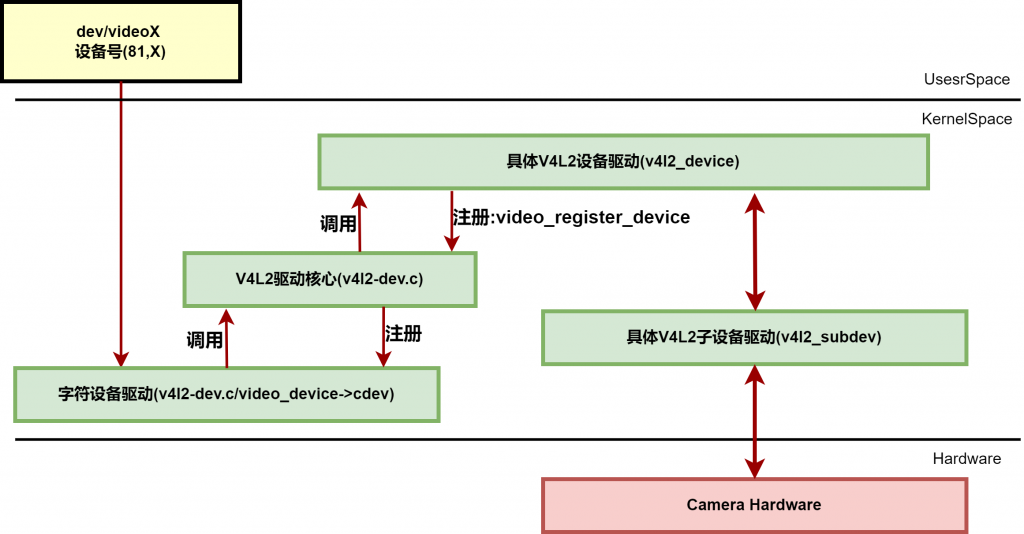
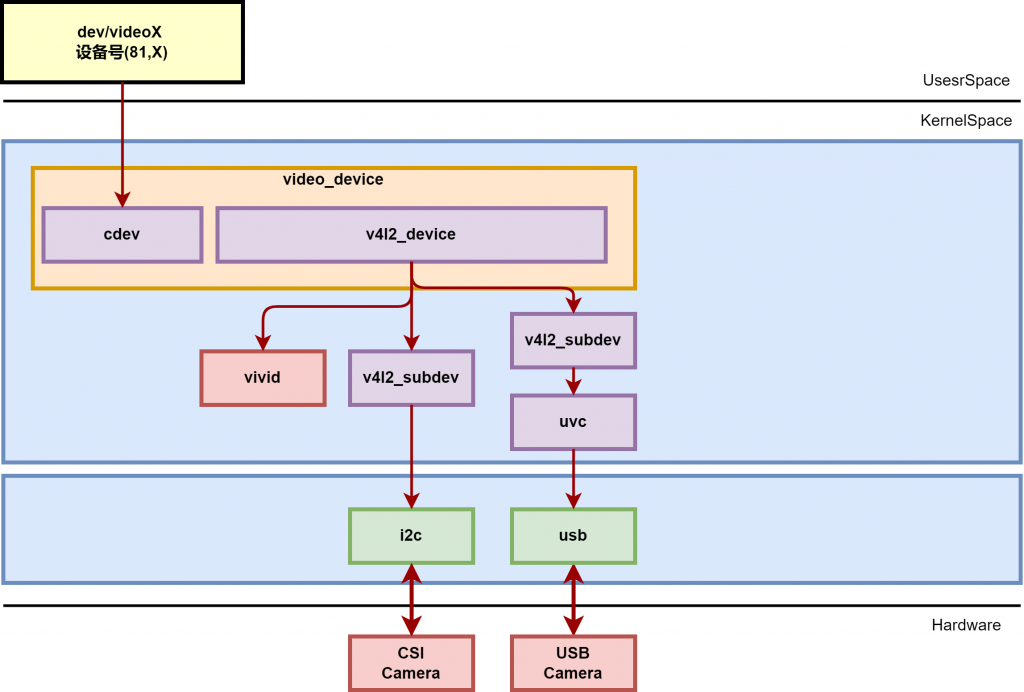
整体框架
完整数据结构关系框图如下:

上面的图看不清,上局部图:

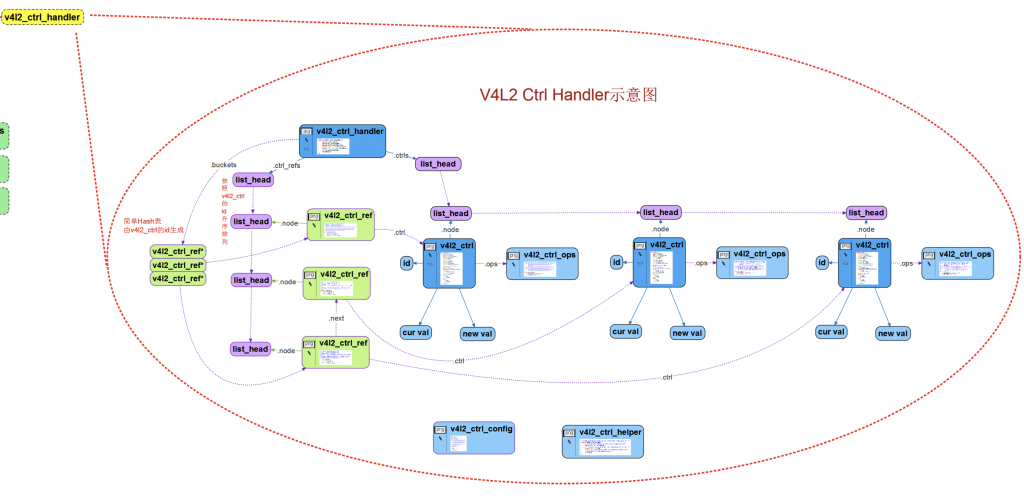
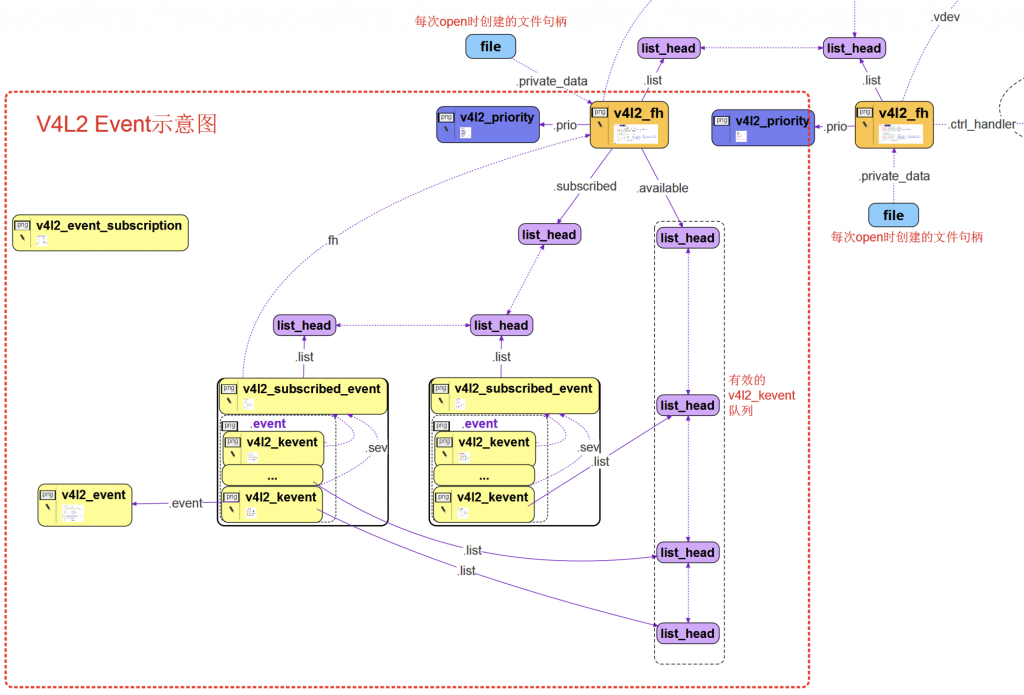
模块划分
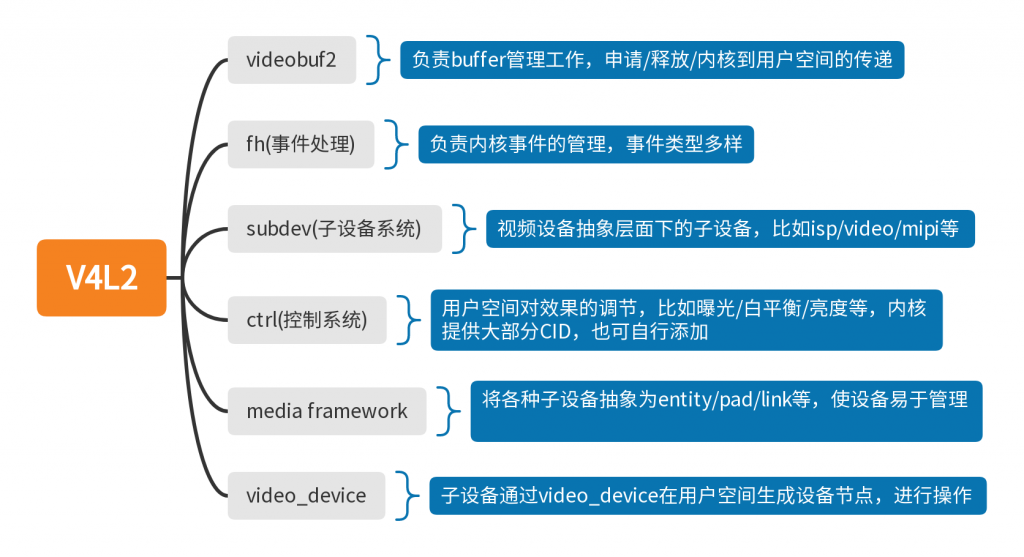
通用API
一个完整的v4l2设备操作流程包含以下步骤:
- 打开设备
- 修改设备属性
- 协商数据格式
- 协商输入输出方法
- 输入输出循环
- 关闭设备

V4L2提供的接口:
- 视频采集接口(video capture interface)
- 视频输出接口(video output interface)
- 直接传输视频接口(video overlay interface)
- 视频间隔消隐信号接口(VBI interface)
- 收音机接口(radio interface)
Streaming I/O
- MMAP:内存映射模式,应用调用VIDIOC_REQBUFS ioctl分配设备buffers,参数标识需要的数目和类型。这个ioctl也可以用来改变buffers的数据以及释放分配的内存,当然这个内存空间一般也是连续的。在应用空间能够访问这些物理地址之前,必须调用mmap函数把这些物理空间映射为用户虚拟地址空间
- USERPTR:用户空间指针,应用层负责分配需要的内存空间,以指针的形式传递给V4L2驱动层,V4L2驱动会把capture的内容保存到指针所指的空间,一般来说,应用层需要确保这个内存空间物理上是连续的
- DMABUF:
MMAP
内存映射缓冲区是在内核开辟的缓冲区。应用通过mmap系统调用映射到用户地址空间,这些缓冲区可以是:
- 大而连续的DMA缓冲区
- vmalloc创建的虚拟缓冲区
- 设备IO内存中开辟的缓冲区(如果硬件支持,比如显卡显存)
实现内存映射机制IO的驱动必须支持如下方法:
- VIDIOC_REQBUFS
- VIDIOC_QUERYBUF
- VIDIOC_QBUF
- VIDIOC_DQBUF
- VIDIOC_STREAMON
- VIDIOC_STREAMOFF
- mmap
- munmap
- select
- poll
实现demo如下:
struct buffer {
void *start;
size_t length;
};
struct buffer *buffers;
static unsigned int n_buffers;
struct v4l2_requestbuffers req;
req.count = 4;
req.type = V4L2_BUF_TYPE_VIDEO_CAPTURE;
req.memory = V4L2_MEMORY_MMAP;
if (-1 == xioctl(fd, VIDIOC_REQBUFS, &req)) {
if (EINVAL == errno) {
fprintf(stderr, "%s does not support "
"memory mapping\n", dev_name);
exit(EXIT_FAILURE);
} else {
errno_exit("VIDIOC_REQBUFS");
}
}
if (req.count < 2) {
fprintf(stderr, "Insufficient buffer memory on %s\n",
dev_name);
exit(EXIT_FAILURE);
}
buffers = calloc(req.count, sizeof(*buffers));
if (!buffers) {
fprintf(stderr, "Out of memory\n");
exit(EXIT_FAILURE);
}
for (n_buffers = 0; n_buffers < req.count; ++n_buffers) {
struct v4l2_buffer buf;
buf.type = V4L2_BUF_TYPE_VIDEO_CAPTURE;
buf.memory = V4L2_MEMORY_MMAP;
buf.index = n_buffers;
if (-1 == xioctl(fd, VIDIOC_QUERYBUF, &buf))
errno_exit("VIDIOC_QUERYBUF");
buffers[n_buffers].length = buf.length;
buffers[n_buffers].start =
mmap(NULL /* start anywhere */,
buf.length,
PROT_READ | PROT_WRITE /* required */,
MAP_SHARED /* recommended */,
fd, buf.m.offset);
if (MAP_FAILED == buffers[n_buffers].start)
errno_exit("mmap");
}
for (i = 0; i < n_buffers; ++i) {
struct v4l2_buffer buf;
buf.type = V4L2_BUF_TYPE_VIDEO_CAPTURE;
buf.memory = V4L2_MEMORY_MMAP;
buf.index = i;
if (-1 == xioctl(fd, VIDIOC_QBUF, &buf))
errno_exit("VIDIOC_QBUF");
}
type = V4L2_BUF_TYPE_VIDEO_CAPTURE;
if (-1 == xioctl(fd, VIDIOC_STREAMON, &type))
errno_exit("VIDIOC_STREAMON");USERPTR
用户空间缓冲区是在用户空间开辟的缓冲区,不需要mmap,必须支持如下方法:
- VIDIOC_REQBUFS
- VIDIOC_QBUF
- VIDIOC_DQBUF
- VIDIOC_STREAMON
- VIDIOC_STREAMOFF
- select
- poll
实现demo如下:
struct buffer {
void *start;
size_t length;
};
struct buffer *buffers;
static unsigned int n_buffers;
struct v4l2_requestbuffers req;
req.count = 4;
req.type = V4L2_BUF_TYPE_VIDEO_CAPTURE;
req.memory = V4L2_MEMORY_USERPTR;
if (-1 == xioctl(fd, VIDIOC_REQBUFS, &req)) {
if (EINVAL == errno) {
fprintf(stderr, "%s does not support "
"user pointer i/o\n", dev_name);
exit(EXIT_FAILURE);
} else {
errno_exit("VIDIOC_REQBUFS");
}
}
buffers = calloc(4, sizeof(*buffers));
if (!buffers) {
fprintf(stderr, "Out of memory\n");
exit(EXIT_FAILURE);
}
for (n_buffers = 0; n_buffers < 4; ++n_buffers) {
buffers[n_buffers].length = buffer_size;
buffers[n_buffers].start = malloc(buffer_size);
if (!buffers[n_buffers].start) {
fprintf(stderr, "Out of memory\n");
exit(EXIT_FAILURE);
}
}
for (i = 0; i < n_buffers; ++i) {
struct v4l2_buffer buf;
CLEAR(buf);
buf.type = V4L2_BUF_TYPE_VIDEO_CAPTURE;
buf.memory = V4L2_MEMORY_USERPTR;
buf.index = i;
buf.m.userptr = (unsigned long)buffers[i].start;
buf.length = buffers[i].length;
if (-1 == xioctl(fd, VIDIOC_QBUF, &buf))
errno_exit("VIDIOC_QBUF");
}
type = V4L2_BUF_TYPE_VIDEO_CAPTURE;
if (-1 == xioctl(fd, VIDIOC_STREAMON, &type))
errno_exit("VIDIOC_STREAMON");DMABUF
使用demo如下:
struct v4l2_requestbuffers reqbuf;
memset(&reqbuf, 0, sizeof (reqbuf));
reqbuf.type = V4L2_BUF_TYPE_VIDEO_CAPTURE;
reqbuf.memory = V4L2_MEMORY_DMABUF;
reqbuf.count = 1;
if (ioctl(fd, VIDIOC_REQBUFS, &reqbuf) == -1) {
if (errno == EINVAL)
printf("Video capturing or DMABUF streaming is not supported\\n");
else
perror("VIDIOC_REQBUFS");
exit(EXIT_FAILURE);
}
...
int buffer_queue(int v4lfd, int index, int dmafd)
{
struct v4l2_buffer buf;
memset(&buf, 0, sizeof buf);
buf.type = V4L2_BUF_TYPE_VIDEO_CAPTURE;
buf.memory = V4L2_MEMORY_DMABUF;
buf.index = index;
buf.m.fd = dmafd;
if (ioctl(v4lfd, VIDIOC_QBUF, &buf) == -1) {
perror("VIDIOC_QBUF");
return -1;
}
return 0;
}编码接口
自2.6内核起,该接口由于种种原因暂停
调试方式
节点
插入USB摄像头之后,video4linux目录中,马上就会出现新的device
fuqiang@fuqiang-virtual:/sys/class/video4linux$ ls -al
total 0
drwxr-xr-x 2 root root 0 8月 19 10:10 .
drwxr-xr-x 81 root root 0 8月 19 10:07 ..
lrwxrwxrwx 1 root root 0 8月 20 09:24 video0 -> ../../devices/pci0000:00/0000:00:15.0/0000:03:00.0/usb3/3-2/3-2:1.0/video4linux/video0
lrwxrwxrwx 1 root root 0 8月 20 09:24 video1 -> ../../devices/pci0000:00/0000:00:15.0/0000:03:00.0/usb3/3-2/3-2:1.0/video4linux/video1
fuqiang@fuqiang-virtual:/sys/class/video4linux$ ls -al /dev/video*
crw-rw----+ 1 root video 81, 0 8月 20 09:24 /dev/video0
crw-rw----+ 1 root video 81, 1 8月 20 09:24 /dev/video1
V4L2默认是编译为模块的
dumpstack
在驱动代码中添加dump_stack(),可以在打印中将堆栈打印出来,用于跟踪代码和调试
流程分析
代码框架
fuqiang@ubuntu:~/workspace/tina-d1-h/lichee/linux-5.4/drivers/media/v4l2-core$ tree
.
├── Kconfig
├── Makefile
├── tuner-core.c
├── v4l2-async.c
├── v4l2-clk.c
├── v4l2-common.c
├── v4l2-compat-ioctl32.c
├── v4l2-ctrls.c //V4L2基础框架
├── v4l2-dev.c //字符设备驱动模块,主要作用申请字符主设备号,注册class和提供video device注册注销等相关函数
├── v4l2-device.c //V4L2基础框架
├── v4l2-dv-timings.c
├── v4l2-event.c
├── v4l2-fh.c //V4L2基础框架
├── v4l2-flash-led-class.c
├── v4l2-fwnode.c
├── v4l2-i2c.c
├── v4l2-ioctl.c //ioctl
├── v4l2-mc.c
├── v4l2-mem2mem.c //内存管理
├── v4l2-spi.c
├── v4l2-subdev.c //V4L2基础框架
├── v4l2-trace.c
├── videobuf-core.c //内存管理
├── videobuf-dma-contig.c //内存管理
├── videobuf-dma-sg.c //内存管理
└── videobuf-vmalloc.c //内存管理
0 directories, 26 files
v4l2-dev.c
该文件主要是负责创建/sys/class/video4linux目录 ,当有设备注册进来时,创建对应的 /dev/videox 、/dev/vbix、/dev/radiox、/dev/subdevx等节点
static int __init videodev_init(void)
{
dev_t dev = MKDEV(VIDEO_MAJOR, 0); //VIDEO_MAJOR:81
int ret;
pr_info("Linux video capture interface: v2.00\n");
ret = register_chrdev_region(dev, VIDEO_NUM_DEVICES, VIDEO_NAME);
//VIDEO_NUM_DEVICES: 256 VIDEO_NAME:"video4linux"
// 1. 将字符设备号(81,0) 到 (81,255) 这期间256个字次设备号,均申请为 v4l2 使用,name=video4linux
if (ret < 0) {
pr_warn("videodev: unable to get major %d\n",
VIDEO_MAJOR);
return ret;
}
ret = class_register(&video_class);
// 2. 注册 /sys/classs/video4linux 目录
if (ret < 0) {
unregister_chrdev_region(dev, VIDEO_NUM_DEVICES);
pr_warn("video_dev: class_register failed\n");
return -EIO;
}
return 0;
}
subsys_initcall(videodev_init);当用设备需要注册为 v4l2 subdev 时,会调用video_register_device()函数进行注册:
int __video_register_device(struct video_device *vdev,
enum vfl_devnode_type type,
int nr, int warn_if_nr_in_use,
struct module *owner)
{
int i = 0;
int ret;
int minor_offset = 0;
int minor_cnt = VIDEO_NUM_DEVICES;
const char *name_base;
/* A minor value of -1 marks this video device as never
having been registered */
vdev->minor = -1;
...
/* v4l2_fh support */
spin_lock_init(&vdev->fh_lock);
INIT_LIST_HEAD(&vdev->fh_list);
// 1. 初始化 fh->list
/* Part 1: check device type */
switch (type) {
case VFL_TYPE_GRABBER:
name_base = "video";
break;
case VFL_TYPE_VBI:
name_base = "vbi";
break;
case VFL_TYPE_RADIO:
name_base = "radio";
break;
case VFL_TYPE_SUBDEV:
name_base = "v4l-subdev";
break;
case VFL_TYPE_SDR:
/* Use device name 'swradio' because 'sdr' was already taken. */
name_base = "swradio";
break;
case VFL_TYPE_TOUCH:
name_base = "v4l-touch";
break;
default:
pr_err("%s called with unknown type: %d\n",
__func__, type);
return -EINVAL;
}
// 2. 检查设备类型
vdev->vfl_type = type;
vdev->cdev = NULL;
if (vdev->dev_parent == NULL)
vdev->dev_parent = vdev->v4l2_dev->dev;
if (vdev->ctrl_handler == NULL)
vdev->ctrl_handler = vdev->v4l2_dev->ctrl_handler;
/* If the prio state pointer is NULL, then use the v4l2_device
prio state. */
if (vdev->prio == NULL)
vdev->prio = &vdev->v4l2_dev->prio;
/* Part 2: find a free minor, device node number and device index. */
#ifdef CONFIG_VIDEO_FIXED_MINOR_RANGES
/* Keep the ranges for the first four types for historical
* reasons.
* Newer devices (not yet in place) should use the range
* of 128-191 and just pick the first free minor there
* (new style). */
switch (type) {
case VFL_TYPE_GRABBER:
minor_offset = 0;
minor_cnt = 64;
break;
case VFL_TYPE_RADIO:
minor_offset = 64;
minor_cnt = 64;
break;
case VFL_TYPE_VBI:
minor_offset = 224;
minor_cnt = 32;
break;
default:
minor_offset = 128;
minor_cnt = 64;
break;
}
#endif
/* Pick a device node number */
mutex_lock(&videodev_lock);
nr = devnode_find(vdev, nr == -1 ? 0 : nr, minor_cnt);
if (nr == minor_cnt)
nr = devnode_find(vdev, 0, minor_cnt);
if (nr == minor_cnt) {
pr_err("could not get a free device node number\n");
mutex_unlock(&videodev_lock);
return -ENFILE;
}
#ifdef CONFIG_VIDEO_FIXED_MINOR_RANGES
/* 1-on-1 mapping of device node number to minor number */
i = nr;
#else
/* The device node number and minor numbers are independent, so
we just find the first free minor number. */
for (i = 0; i < VIDEO_NUM_DEVICES; i++)
if (video_devices[i] == NULL)
break;
if (i == VIDEO_NUM_DEVICES) {
mutex_unlock(&videodev_lock);
pr_err("could not get a free minor\n");
return -ENFILE;
}
#endif
vdev->minor = i + minor_offset;
vdev->num = nr;
// 3. 寻找一个不在使用的 次设备号, 主设备号为 81,(0~63 为video)(128,191 为sub-dev)
/* Should not happen since we thought this minor was free */
if (WARN_ON(video_devices[vdev->minor])) {
mutex_unlock(&videodev_lock);
pr_err("video_device not empty!\n");
return -ENFILE;
}
devnode_set(vdev);
vdev->index = get_index(vdev);
video_devices[vdev->minor] = vdev;
mutex_unlock(&videodev_lock);
if (vdev->ioctl_ops)
determine_valid_ioctls(vdev);
// 4. 获取 index,将当前需要注册的 video_device 设备保存在 video_device[]全局数组中
/* Part 3: Initialize the character device */
vdev->cdev = cdev_alloc();
if (vdev->cdev == NULL) {
ret = -ENOMEM;
goto cleanup;
}
vdev->cdev->ops = &v4l2_fops;
vdev->cdev->owner = owner;
ret = cdev_add(vdev->cdev, MKDEV(VIDEO_MAJOR, vdev->minor), 1);
if (ret < 0) {
pr_err("%s: cdev_add failed\n", __func__);
kfree(vdev->cdev);
vdev->cdev = NULL;
goto cleanup;
}
// 5. 分配对应的字符设备 /dev/video0,字符设备号,就是前面的 (81,minor)
/* Part 4: register the device with sysfs */
vdev->dev.class = &video_class;
vdev->dev.devt = MKDEV(VIDEO_MAJOR, vdev->minor);
vdev->dev.parent = vdev->dev_parent;
dev_set_name(&vdev->dev, "%s%d", name_base, vdev->num);
ret = device_register(&vdev->dev);
if (ret < 0) {
pr_err("%s: device_register failed\n", __func__);
goto cleanup;
}
// 6. 分配对应的sys节点 /sys/class/video4linux/video0
/* Register the release callback that will be called when the last
reference to the device goes away. */
vdev->dev.release = v4l2_device_release;
if (nr != -1 && nr != vdev->num && warn_if_nr_in_use)
pr_warn("%s: requested %s%d, got %s\n", __func__,
name_base, nr, video_device_node_name(vdev));
/* Increase v4l2_device refcount */
v4l2_device_get(vdev->v4l2_dev);
// 7. 注册release 时调用的函数
/* Part 5: Register the entity. */
ret = video_register_media_controller(vdev);
// 8. 将该 v4l2 subdevice 当成一个 entity 注册到 media device
/* Part 6: Activate this minor. The char device can now be used. */
set_bit(V4L2_FL_REGISTERED, &vdev->flags);
return 0;
cleanup:
mutex_lock(&videodev_lock);
if (vdev->cdev)
cdev_del(vdev->cdev);
video_devices[vdev->minor] = NULL;
devnode_clear(vdev);
mutex_unlock(&videodev_lock);
/* Mark this video device as never having been registered. */
vdev->minor = -1;
return ret;
}
EXPORT_SYMBOL(__video_register_device);字符设备操作函数 v4l2_fops:
static const struct file_operations v4l2_fops = {
.owner = THIS_MODULE,
.read = v4l2_read,
.write = v4l2_write,
.open = v4l2_open,
.get_unmapped_area = v4l2_get_unmapped_area,
.mmap = v4l2_mmap,
.unlocked_ioctl = v4l2_ioctl,
#ifdef CONFIG_COMPAT
.compat_ioctl = v4l2_compat_ioctl32,
#endif
.release = v4l2_release,
.poll = v4l2_poll,
.llseek = no_llseek,
};
int __video_register_device(struct video_device *vdev,
enum vfl_devnode_type type,
int nr, int warn_if_nr_in_use,
struct module *owner)
...
/* Part 3: Initialize the character device */
vdev->cdev = cdev_alloc();
if (vdev->cdev == NULL) {
ret = -ENOMEM;
goto cleanup;
}
vdev->cdev->ops = &v4l2_fops;
vdev->cdev->owner = owner;
ret = cdev_add(vdev->cdev, MKDEV(VIDEO_MAJOR, vdev->minor), 1);
if (ret < 0) {
pr_err("%s: cdev_add failed\n", __func__);
kfree(vdev->cdev);
vdev->cdev = NULL;
goto cleanup;
}
...
}设备注册流程
以vivid虚拟驱动为例
static int vivid_probe(struct platform_device *pdev)
{
const struct font_desc *font = find_font("VGA8x16");
int ret = 0, i;
if (font == NULL) {
pr_err("vivid: could not find font\n");
return -ENODEV;
}
tpg_set_font(font->data);
n_devs = clamp_t(unsigned, n_devs, 1, VIVID_MAX_DEVS);
for (i = 0; i < n_devs; i++) {
ret = vivid_create_instance(pdev, i);
if (ret) {
/* If some instantiations succeeded, keep driver */
if (i)
ret = 0;
break;
}
}
if (ret < 0) {
pr_err("vivid: error %d while loading driver\n", ret);
return ret;
}
/* n_devs will reflect the actual number of allocated devices */
n_devs = i;
return ret;
}
static struct platform_device vivid_pdev = {
.name = "vivid",
.dev.release = vivid_pdev_release,
};
static struct platform_driver vivid_pdrv = {
.probe = vivid_probe,
.remove = vivid_remove,
.driver = {
.name = "vivid",
},
};
static int __init vivid_init(void)
{
int ret;
ret = platform_device_register(&vivid_pdev);
if (ret)
return ret;
ret = platform_driver_register(&vivid_pdrv);
if (ret)
platform_device_unregister(&vivid_pdev);
return ret;
}
module_init(vivid_init);vivid_create_instance完成了完整的注册工作:
static int vivid_create_instance(struct platform_device *pdev, int inst)
{
...
struct vivid_dev *dev;
struct video_device *vfd;
...
/* allocate main vivid state structure */
dev = kzalloc(sizeof(*dev), GFP_KERNEL);
...
/* register v4l2_device */
snprintf(dev->v4l2_dev.name, sizeof(dev->v4l2_dev.name),
"%s-%03d", VIVID_MODULE_NAME, inst);
ret = v4l2_device_register(&pdev->dev, &dev->v4l2_dev);
...
//dev结构体的一些初始化
...
if (dev->has_vid_cap) {
vfd = &dev->vid_cap_dev;
vfd->fops = &vivid_fops;
vfd->ioctl_ops = &vivid_ioctl_ops;
vfd->device_caps = dev->vid_cap_caps;
vfd->release = video_device_release_empty;
vfd->v4l2_dev = &dev->v4l2_dev;
vfd->queue = &dev->vb_vid_cap_q;
vfd->tvnorms = tvnorms_cap;
/*
* Provide a mutex to v4l2 core. It will be used to protect
* all fops and v4l2 ioctls.
*/
vfd->lock = &dev->mutex;
video_set_drvdata(vfd, dev);
ret = video_register_device(vfd, VFL_TYPE_GRABBER, vid_cap_nr[inst]);
if (ret < 0)
goto unreg_dev;
v4l2_info(&dev->v4l2_dev, "V4L2 capture device registered as %s\n",
video_device_node_name(vfd));
}open流程
/* Override for the open function */
static int v4l2_open(struct inode *inode, struct file *filp)
{
struct video_device *vdev;
int ret = 0;
/* Check if the video device is available */
mutex_lock(&videodev_lock);
vdev = video_devdata(filp);
/* return ENODEV if the video device has already been removed. */
if (vdev == NULL || !video_is_registered(vdev)) {
mutex_unlock(&videodev_lock);
return -ENODEV;
}
/* and increase the device refcount */
video_get(vdev);
mutex_unlock(&videodev_lock);
if (vdev->fops->open) {
if (video_is_registered(vdev))
ret = vdev->fops->open(filp);
else
ret = -ENODEV;
}
if (vdev->dev_debug & V4L2_DEV_DEBUG_FOP)
dprintk("%s: open (%d)\n",
video_device_node_name(vdev), ret);
/* decrease the refcount in case of an error */
if (ret)
video_put(vdev);
return ret;
}
static const struct file_operations v4l2_fops = {
.owner = THIS_MODULE,
.read = v4l2_read,
.write = v4l2_write,
.open = v4l2_open,
.get_unmapped_area = v4l2_get_unmapped_area,
.mmap = v4l2_mmap,
.unlocked_ioctl = v4l2_ioctl,
#ifdef CONFIG_COMPAT
.compat_ioctl = v4l2_compat_ioctl32,
#endif
.release = v4l2_release,
.poll = v4l2_poll,
.llseek = no_llseek,
};转到v4l2_device中
int v4l2_device_register_subdev_nodes(struct v4l2_device *v4l2_dev)
{
struct video_device *vdev;
struct v4l2_subdev *sd;
int err;
/* Register a device node for every subdev marked with the
* V4L2_SUBDEV_FL_HAS_DEVNODE flag.
*/
list_for_each_entry(sd, &v4l2_dev->subdevs, list) {
if (!(sd->flags & V4L2_SUBDEV_FL_HAS_DEVNODE))
continue;
if (sd->devnode)
continue;
vdev = kzalloc(sizeof(*vdev), GFP_KERNEL);
if (!vdev) {
err = -ENOMEM;
goto clean_up;
}
video_set_drvdata(vdev, sd);
strscpy(vdev->name, sd->name, sizeof(vdev->name));
vdev->dev_parent = sd->dev;
vdev->v4l2_dev = v4l2_dev;
vdev->fops = &v4l2_subdev_fops;
vdev->release = v4l2_device_release_subdev_node;
vdev->ctrl_handler = sd->ctrl_handler;
err = __video_register_device(vdev, VFL_TYPE_SUBDEV, -1, 1,
sd->owner);
if (err < 0) {
kfree(vdev);
goto clean_up;
}
sd->devnode = vdev;
}
return 0;
}
static int subdev_open(struct file *file)
{
struct video_device *vdev = video_devdata(file);
struct v4l2_subdev *sd = vdev_to_v4l2_subdev(vdev);
struct v4l2_subdev_fh *subdev_fh;
int ret;
subdev_fh = kzalloc(sizeof(*subdev_fh), GFP_KERNEL);
if (subdev_fh == NULL)
return -ENOMEM;
ret = subdev_fh_init(subdev_fh, sd);
if (ret) {
kfree(subdev_fh);
return ret;
}
v4l2_fh_init(&subdev_fh->vfh, vdev);
v4l2_fh_add(&subdev_fh->vfh);
file->private_data = &subdev_fh->vfh;
if (sd->internal_ops && sd->internal_ops->open) {
ret = sd->internal_ops->open(sd, subdev_fh);
if (ret < 0)
goto err;
}
return 0;
}ioctl流程
static long v4l2_ioctl(struct file *filp, unsigned int cmd, unsigned long arg)
{
struct video_device *vdev = video_devdata(filp);
int ret = -ENODEV;
if (vdev->fops->unlocked_ioctl) {
if (video_is_registered(vdev))
ret = vdev->fops->unlocked_ioctl(filp, cmd, arg);
} else
ret = -ENOTTY;
return ret;
}转到vivid_core.c中
static const struct v4l2_file_operations vivid_radio_fops = {
.owner = THIS_MODULE,
.open = v4l2_fh_open,
.release = vivid_fop_release,
.read = vivid_radio_read,
.write = vivid_radio_write,
.poll = vivid_radio_poll,
.unlocked_ioctl = video_ioctl2,
};
long video_ioctl2(struct file *file,
unsigned int cmd, unsigned long arg)
{
return video_usercopy(file, cmd, arg, __video_do_ioctl);
}
EXPORT_SYMBOL(video_ioctl2);
转到v4L2-ioctl.c
static long __video_do_ioctl(struct file *file,
unsigned int cmd, void *arg)
{
...
const struct v4l2_ioctl_ops *ops = vfd->ioctl_ops;
const struct v4l2_ioctl_info *info;
...
if (info != &default_info) {
ret = info->func(ops, file, fh, arg);
} else if (!ops->vidioc_default) {
ret = -ENOTTY;
} else {
ret = ops->vidioc_default(file, fh,
vfh ? v4l2_prio_check(vfd->prio, vfh->prio) >= 0 : 0,
cmd, arg);
}
static const struct v4l2_ioctl_info v4l2_ioctls[] = {
IOCTL_INFO(VIDIOC_QUERYCAP, v4l_querycap, v4l_print_querycap, 0),
IOCTL_INFO(VIDIOC_ENUM_FMT, v4l_enum_fmt, v4l_print_fmtdesc, INFO_FL_CLEAR(v4l2_fmtdesc, type)),
IOCTL_INFO(VIDIOC_G_FMT, v4l_g_fmt, v4l_print_format, 0),
IOCTL_INFO(VIDIOC_S_FMT, v4l_s_fmt, v4l_print_format, INFO_FL_PRIO),
IOCTL_INFO(VIDIOC_REQBUFS, v4l_reqbufs, v4l_print_requestbuffers, INFO_FL_PRIO | INFO_FL_QUEUE),
IOCTL_INFO(VIDIOC_QUERYBUF, v4l_querybuf, v4l_print_buffer, INFO_FL_QUEUE | INFO_FL_CLEAR(v4l2_buffer, length)),
IOCTL_INFO(VIDIOC_G_FBUF, v4l_stub_g_fbuf, v4l_print_framebuffer, 0),
...
}
static int v4l_s_fmt(const struct v4l2_ioctl_ops *ops,
struct file *file, void *fh, void *arg)
{
struct v4l2_format *p = arg;
struct video_device *vfd = video_devdata(file);
int ret = check_fmt(file, p->type);
unsigned int i;
if (ret)
return ret;
ret = v4l_enable_media_source(vfd);
if (ret)
return ret;
v4l_sanitize_format(p);
switch (p->type) {
case V4L2_BUF_TYPE_VIDEO_CAPTURE:
if (unlikely(!ops->vidioc_s_fmt_vid_cap))
break;
CLEAR_AFTER_FIELD(p, fmt.pix);
ret = ops->vidioc_s_fmt_vid_cap(file, fh, arg);
/* just in case the driver zeroed it again */
p->fmt.pix.priv = V4L2_PIX_FMT_PRIV_MAGIC;
if (vfd->vfl_type == VFL_TYPE_TOUCH)
v4l_pix_format_touch(&p->fmt.pix);
return ret;
...
回到vivid-core.c
static const struct v4l2_ioctl_ops vivid_ioctl_ops = {
.vidioc_querycap = vidioc_querycap,
.vidioc_enum_fmt_vid_cap = vivid_enum_fmt_vid,
.vidioc_g_fmt_vid_cap = vidioc_g_fmt_vid_cap,
.vidioc_try_fmt_vid_cap = vidioc_try_fmt_vid_cap,
.vidioc_s_fmt_vid_cap = vidioc_s_fmt_vid_cap,
.vidioc_g_fmt_vid_cap_mplane = vidioc_g_fmt_vid_cap_mplane,
.vidioc_try_fmt_vid_cap_mplane = vidioc_try_fmt_vid_cap_mplane,
...
}内存申请流程
前面ioctl流程是一样的,直接到v4l2-ioctl.c
static int v4l_reqbufs(const struct v4l2_ioctl_ops *ops,
struct file *file, void *fh, void *arg)
{
struct v4l2_requestbuffers *p = arg;
int ret = check_fmt(file, p->type);
if (ret)
return ret;
CLEAR_AFTER_FIELD(p, capabilities);
return ops->vidioc_reqbufs(file, fh, p);
}
这里调用到vivid驱动里面,然后转到videobuf2-v4l2.c
int vb2_ioctl_reqbufs(struct file *file, void *priv,
struct v4l2_requestbuffers *p)
{
struct video_device *vdev = video_devdata(file);
int res = vb2_verify_memory_type(vdev->queue, p->memory, p->type);
fill_buf_caps(vdev->queue, &p->capabilities);
if (res)
return res;
if (vb2_queue_is_busy(vdev, file))
return -EBUSY;
res = vb2_core_reqbufs(vdev->queue, p->memory, &p->count);
/* If count == 0, then the owner has released all buffers and he
is no longer owner of the queue. Otherwise we have a new owner. */
if (res == 0)
vdev->queue->owner = p->count ? file->private_data : NULL;
return res;
}转到videobuf2-core.c
int vb2_core_reqbufs(struct vb2_queue *q, enum vb2_memory memory,
unsigned int *count)
{
unsigned int num_buffers, allocated_buffers, num_planes = 0;
unsigned plane_sizes[VB2_MAX_PLANES] = { };
unsigned int i;
int ret;
if (*count == 0 || q->num_buffers != 0 ||
(q->memory != VB2_MEMORY_UNKNOWN && q->memory != memory)) {
//如果vb2_queue中还有buffer。对这些buffer进行检查释放
/*
* We already have buffers allocated, so first check if they
* are not in use and can be freed.
*/
mutex_lock(&q->mmap_lock);
if (debug && q->memory == VB2_MEMORY_MMAP &&
__buffers_in_use(q))
dprintk(1, "memory in use, orphaning buffers\n");
/*
* Call queue_cancel to clean up any buffers in the
* QUEUED state which is possible if buffers were prepared or
* queued without ever calling STREAMON.
*/
__vb2_queue_cancel(q);
ret = __vb2_queue_free(q, q->num_buffers);
mutex_unlock(&q->mmap_lock);
if (ret)
return ret;
/*
* In case of REQBUFS(0) return immediately without calling
* driver's queue_setup() callback and allocating resources.
*/
if (*count == 0) //如果申请分配的count为0,不做任何操作
return 0;
}
/*
* Make sure the requested values and current defaults are sane.
*/
WARN_ON(q->min_buffers_needed > VB2_MAX_FRAME);
num_buffers = max_t(unsigned int, *count, q->min_buffers_needed);
num_buffers = min_t(unsigned int, num_buffers, VB2_MAX_FRAME);
memset(q->alloc_devs, 0, sizeof(q->alloc_devs));
q->memory = memory;
/*
* Ask the driver how many buffers and planes per buffer it requires.
* Driver also sets the size and allocator context for each plane.
*/
ret = call_qop(q, queue_setup, q, &num_buffers, &num_planes,
plane_sizes, q->alloc_devs);
if (ret)
return ret;
/* Check that driver has set sane values */
if (WARN_ON(!num_planes))
return -EINVAL;
for (i = 0; i < num_planes; i++)
if (WARN_ON(!plane_sizes[i]))
return -EINVAL;
/* Finally, allocate buffers and video memory */
allocated_buffers =
__vb2_queue_alloc(q, memory, num_buffers, num_planes, plane_sizes);
if (allocated_buffers == 0) {
dprintk(1, "memory allocation failed\n");
return -ENOMEM;
}
/*
* There is no point in continuing if we can't allocate the minimum
* number of buffers needed by this vb2_queue.
*/
if (allocated_buffers < q->min_buffers_needed)
ret = -ENOMEM;
/*
* Check if driver can handle the allocated number of buffers.
*/
if (!ret && allocated_buffers < num_buffers) {
num_buffers = allocated_buffers;
/*
* num_planes is set by the previous queue_setup(), but since it
* signals to queue_setup() whether it is called from create_bufs()
* vs reqbufs() we zero it here to signal that queue_setup() is
* called for the reqbufs() case.
*/
num_planes = 0;
ret = call_qop(q, queue_setup, q, &num_buffers,
&num_planes, plane_sizes, q->alloc_devs);
if (!ret && allocated_buffers < num_buffers)
ret = -ENOMEM;
/*
* Either the driver has accepted a smaller number of buffers,
* or .queue_setup() returned an error
*/
}
mutex_lock(&q->mmap_lock);
q->num_buffers = allocated_buffers;
if (ret < 0) {
/*
* Note: __vb2_queue_free() will subtract 'allocated_buffers'
* from q->num_buffers.
*/
__vb2_queue_free(q, allocated_buffers);
mutex_unlock(&q->mmap_lock);
return ret;
}
mutex_unlock(&q->mmap_lock);
/*
* Return the number of successfully allocated buffers
* to the userspace.
*/
*count = allocated_buffers;
q->waiting_for_buffers = !q->is_output;
return 0;
}
EXPORT_SYMBOL_GPL(vb2_core_reqbufs);
static int __vb2_queue_alloc(struct vb2_queue *q, enum vb2_memory memory,
unsigned int num_buffers, unsigned int num_planes,
const unsigned plane_sizes[VB2_MAX_PLANES])
{
unsigned int buffer, plane;
struct vb2_buffer *vb;
int ret;
/* Ensure that q->num_buffers+num_buffers is below VB2_MAX_FRAME */
num_buffers = min_t(unsigned int, num_buffers,
VB2_MAX_FRAME - q->num_buffers);
for (buffer = 0; buffer < num_buffers; ++buffer) {
/* Allocate videobuf buffer structures */
vb = kzalloc(q->buf_struct_size, GFP_KERNEL);
if (!vb) {
dprintk(1, "memory alloc for buffer struct failed\n");
break;
}
vb->state = VB2_BUF_STATE_DEQUEUED;
vb->vb2_queue = q;
vb->num_planes = num_planes;
vb->index = q->num_buffers + buffer;
vb->type = q->type;
vb->memory = memory;
for (plane = 0; plane < num_planes; ++plane) {
vb->planes[plane].length = plane_sizes[plane];
vb->planes[plane].min_length = plane_sizes[plane];
}
call_void_bufop(q, init_buffer, vb);
q->bufs[vb->index] = vb;
/* Allocate video buffer memory for the MMAP type */
if (memory == VB2_MEMORY_MMAP) {
ret = __vb2_buf_mem_alloc(vb);
if (ret) {
dprintk(1, "failed allocating memory for buffer %d\n",
buffer);
q->bufs[vb->index] = NULL;
kfree(vb);
break;
}
__setup_offsets(vb);
/*
* Call the driver-provided buffer initialization
* callback, if given. An error in initialization
* results in queue setup failure.
*/
ret = call_vb_qop(vb, buf_init, vb);
if (ret) {
dprintk(1, "buffer %d %p initialization failed\n",
buffer, vb);
__vb2_buf_mem_free(vb);
q->bufs[vb->index] = NULL;
kfree(vb);
break;
}
}
}
dprintk(1, "allocated %d buffers, %d plane(s) each\n",
buffer, num_planes);
return buffer;
}
static int __vb2_buf_mem_alloc(struct vb2_buffer *vb)
{
struct vb2_queue *q = vb->vb2_queue;
void *mem_priv;
int plane;
int ret = -ENOMEM;
/*
* Allocate memory for all planes in this buffer
* NOTE: mmapped areas should be page aligned
*/
for (plane = 0; plane < vb->num_planes; ++plane) {
/* Memops alloc requires size to be page aligned. */
unsigned long size = PAGE_ALIGN(vb->planes[plane].length);
/* Did it wrap around? */
if (size < vb->planes[plane].length)
goto free;
mem_priv = call_ptr_memop(vb, alloc,
q->alloc_devs[plane] ? : q->dev,
q->dma_attrs, size, q->dma_dir, q->gfp_flags);
if (IS_ERR_OR_NULL(mem_priv)) {
if (mem_priv)
ret = PTR_ERR(mem_priv);
goto free;
}
/* Associate allocator private data with this plane */
vb->planes[plane].mem_priv = mem_priv;
}
return 0;
free:
/* Free already allocated memory if one of the allocations failed */
for (; plane > 0; --plane) {
call_void_memop(vb, put, vb->planes[plane - 1].mem_priv);
vb->planes[plane - 1].mem_priv = NULL;
}
return ret;
}streaming on流程
细节
UVC-usb摄像头流程分析
- UVC: USB Video Class
- UVC驱动:drivers\media\video\uvc\
- www.usb.org可以下载 uvc specification,UVC 1.5 Class specification.pdf : 有详细描述
驱动注册
--------------------------------------uvc_driver.c----------------------------------------
1. usb_register(&uvc_driver.driver);
2. uvc_probe
uvc_register_video
vdev = video_device_alloc();
vdev->fops = &uvc_fops;
video_register_device
struct uvc_driver uvc_driver = {
.driver = {
.name = "uvcvideo",
.probe = uvc_probe,
.disconnect = uvc_disconnect,
.suspend = uvc_suspend,
.resume = uvc_resume,
.reset_resume = uvc_reset_resume,
.id_table = uvc_ids,
.supports_autosuspend = 1,
},
};
static int __init uvc_init(void)
{
int ret;
uvc_debugfs_init();
ret = usb_register(&uvc_driver.driver);
if (ret < 0) {
uvc_debugfs_cleanup();
return ret;
}
printk(KERN_INFO DRIVER_DESC " (" DRIVER_VERSION ")\n");
return 0;
}
设备操作
--------------------------------------uvc_v4l2.c----------------------------------------
const struct v4l2_file_operations uvc_fops = {
.owner = THIS_MODULE,
.open = uvc_v4l2_open,
.release = uvc_v4l2_release,
.unlocked_ioctl = video_ioctl2,
#ifdef CONFIG_COMPAT
.compat_ioctl32 = uvc_v4l2_compat_ioctl32,
#endif
.read = uvc_v4l2_read,
.mmap = uvc_v4l2_mmap,
.poll = uvc_v4l2_poll,
#ifndef CONFIG_MMU
.get_unmapped_area = uvc_v4l2_get_unmapped_area,
#endif
};
v4l-utils
下载(Index of /downloads/v4l-utils (linuxtv.org))
$ wget http://linuxtv.org/downloads/v4l-utils/v4l-utils-x.y.z.tar.bz2
$ tar xvfj v4l-utils-x.y.z.tar.bz2
$ cd v4l-utils-x.y.z编译
./configure
make
sudo make install






















 1666
1666











 被折叠的 条评论
为什么被折叠?
被折叠的 条评论
为什么被折叠?










